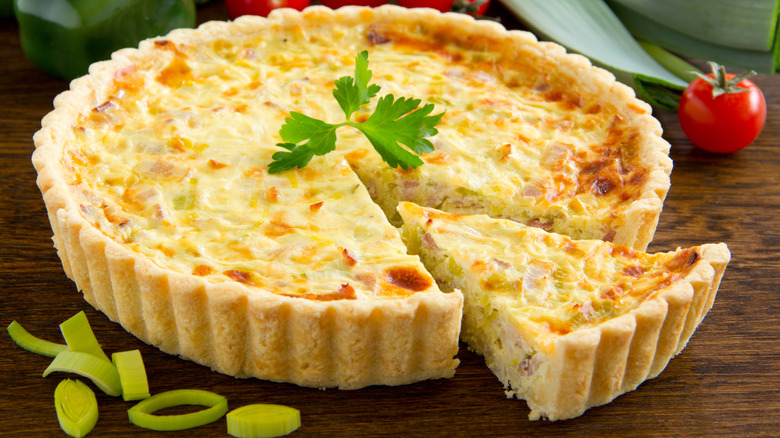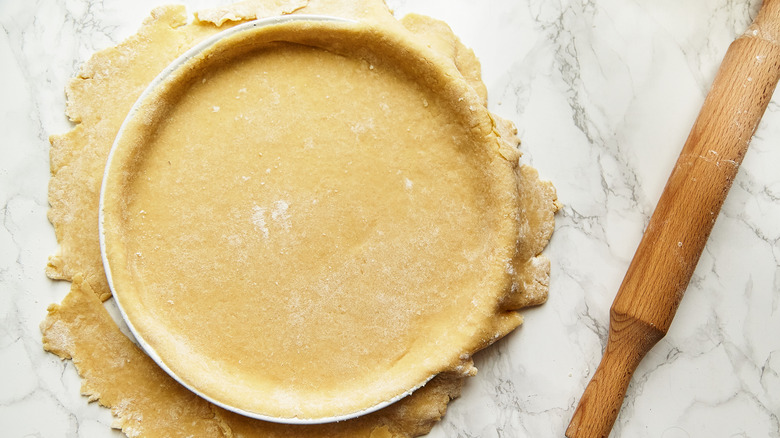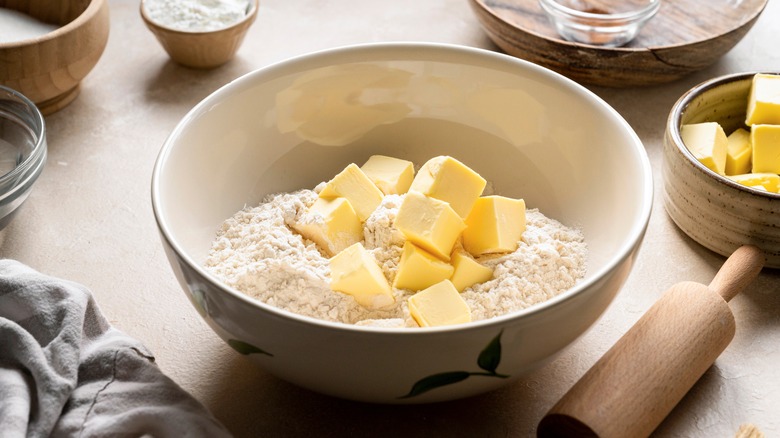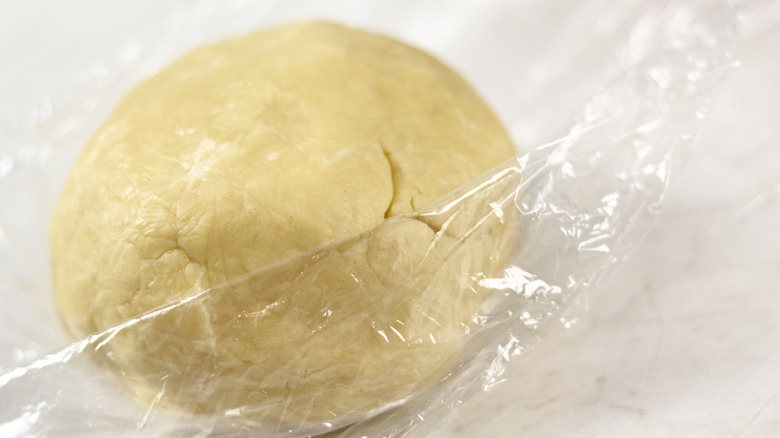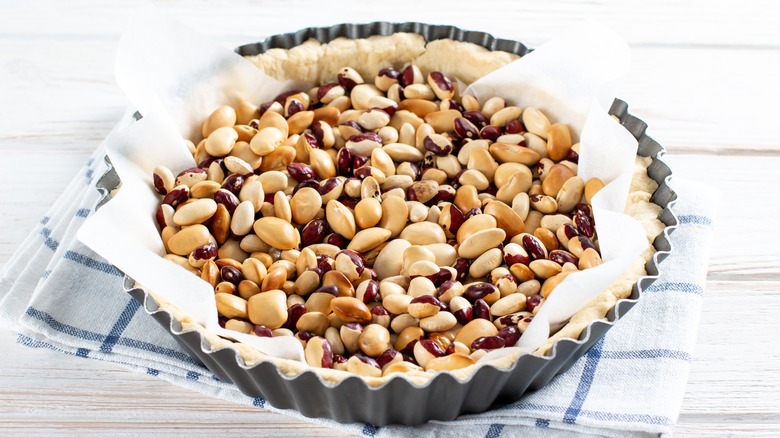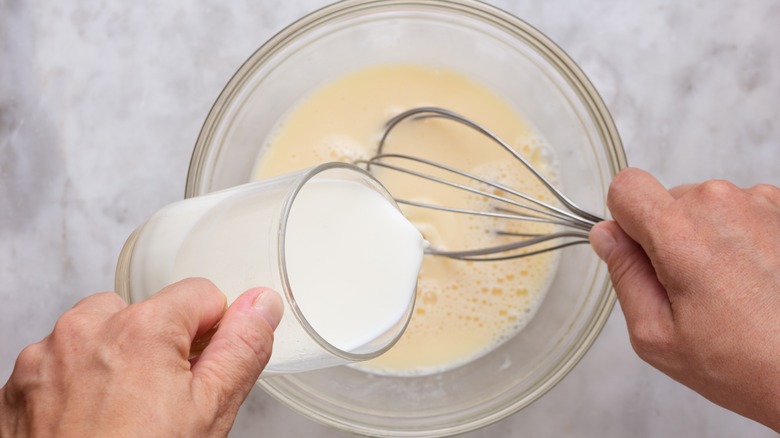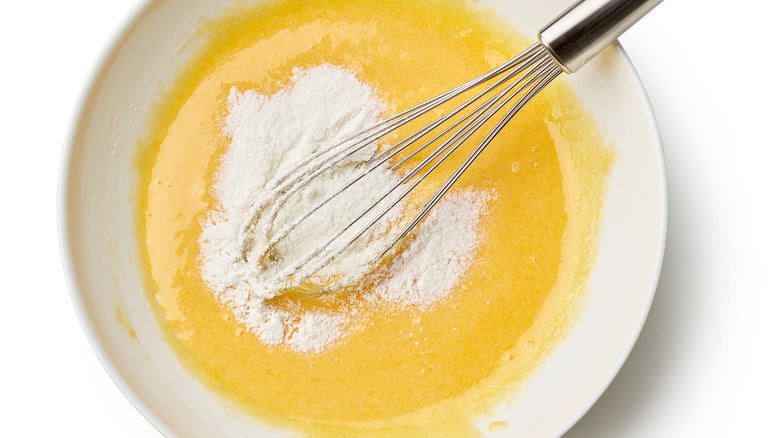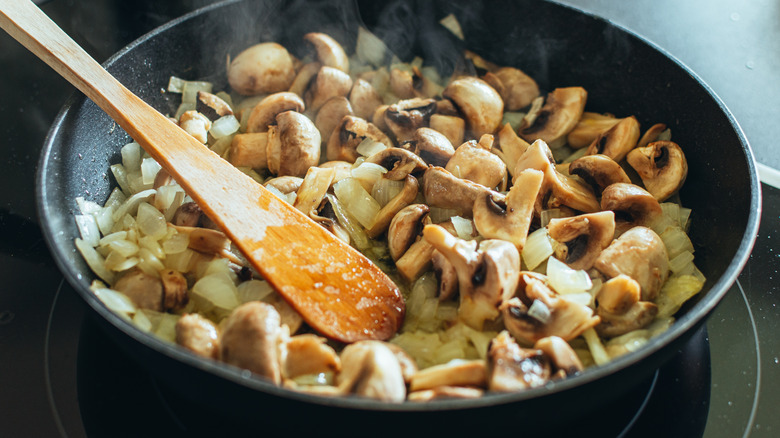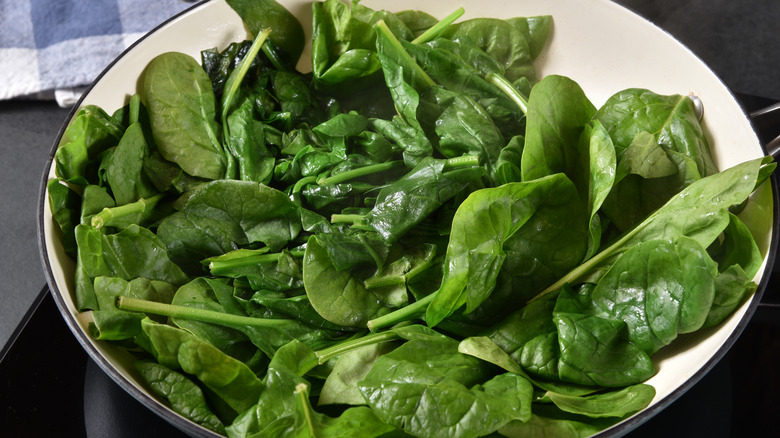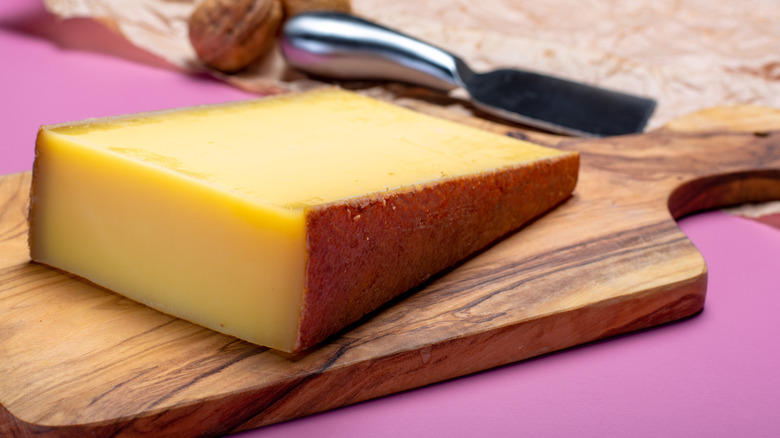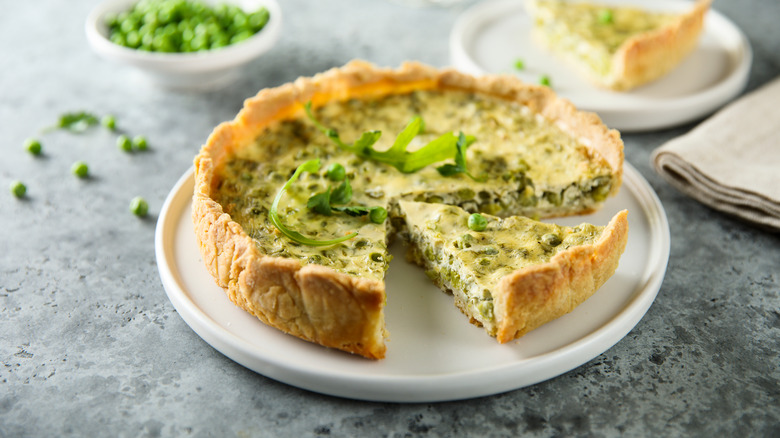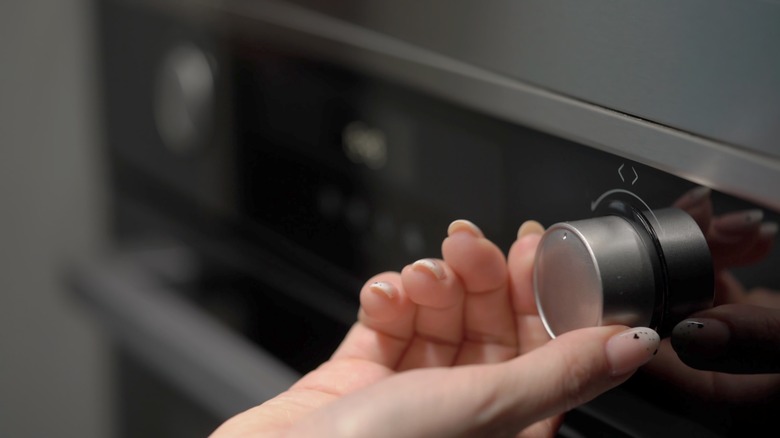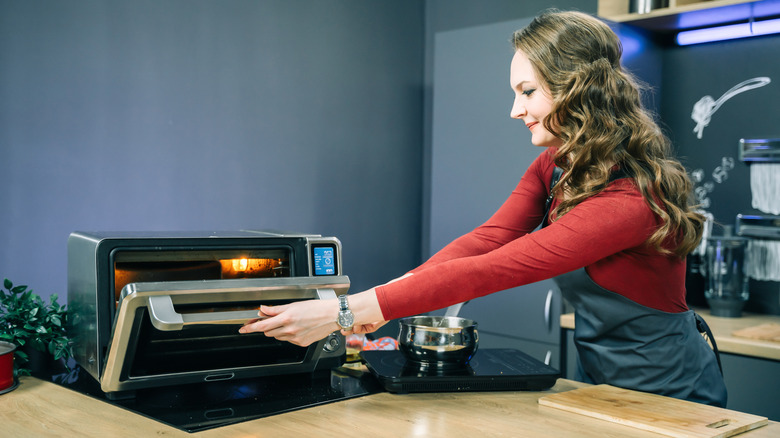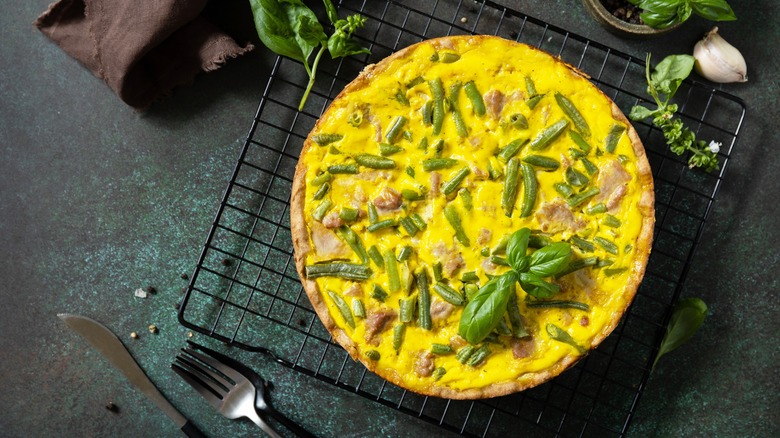14 Tips For Making Quiche The Proper Way
While quiche may be a somewhat posh indulgence, it actually originated as a poor man's fare (via National Today). It is much more than a baked item that is made of eggs, cream, and bacon or cubes of fat served up in a skillet crust made out of bread.
And contrary to popular belief, the ever-so-popular quiche originated in Germany, not France. It was called "Kuchen" ("cake" in German), then later renamed "Kische." Quiche Lorraine evolved after the French invaded the German town of Lothringen during the Middle Ages.
They took this delicious dish and renamed it Quiche (from "Kische") Lorraine in honor of the region where it was first popularized. Ingredients like cheese and onions were added later, and the crusty bread evolved into a more fanciful pastry.
Julia Child brought Quiche Lorraine to America's kitchens via her 1963 TV series "The French Chef" and her subsequent cookbook of the same name (via GBH). Child demystified truly French cuisine: After all, quiche is just a custard baked in a pie shell.
The quality of a good quiche is dependent on various factors such as consistency, flavor, and overall mouthfeel. Each mouthwatering bite contains a smooth velvety custard-like filling that is complemented by a flakey, golden crust. Though you can customize the fillings to your liking, there are some basic rules to follow if you want to make a proper quiche. And by proper, we mean tried-and-true and ultimately delicious.
1. Choose the right type of crust
You wouldn't serve a quiche in a graham cracker crust, no more than you'd serve a cake drizzled with gravy. This savory pie essentially requires a pastry crust. All it takes is flour, butter, and a rolling pin, according to chef Andrew Zimmern (via Daily News).
The standard ratio is three parts flour to one part fat (via HuffPost). If you don't want to get flour on your face (or simply don't have the time), you can always opt for a pre-made crust such as Pillsbury Pie Crust and Wholly Wholesome Traditional Pie Shells.
But, if you choose to go the homemade route, Daily Meal's Favorite Pie Crust recipe is a great option. Yes, this requires a few more ingredients than your basic flour and butter recipe (small amounts of sugar, salt, and optionally cream), but it's nonetheless quite simple. You'll need a food processor, wax paper, and a rolling pin to get started.
2. Don't overmix the dough
So, you've decided to make your own crust. Fear not: You don't need to be a pastry chef to produce a tender, flaky crust. But you do need to follow specific directions, and these include how you mix your ingredients. Overmixing the dough can result in a tough crust (via Bon Appétit). So, pulse the dough (don't process it) if you're using a food processor. Aim for mostly pea-sized particles: You don't want it too crumbly, or it won't hold together.
Making an easy pie crust is relatively straightforward. To help prevent overmixing, consider grating frozen butter first. Then, incorporate bits of butter into your flour mixture. Less time and effort mean that you won't be overworking your ingredients. Using cold butter and some ice water prevents the butter from melting into the mixture as you incorporate the ingredients. You don't want a complete blend: In fact, those specs of butter floating in your dough help bring about a flakier crust.
3. Chill the dough
Quiche is a dish that requires time in addition to physical preparation and baking. So, make sure to account for the time it takes to set your dough properly. That's because chilling your dough for at least an hour is a necessary step in making a proper pie crust, according to Qi Ai, chef de cuisine at Travelle at The Langham in Chicago.
But why is it so important to chill your dough? Chilling dough helps keep the fats solid (via King Arthur Baking). This is important for maintaining the crust's structure as it bakes. And it will help prevent dough from sticking to your rolling pan and your fingers.
You only need to rest your dough a few minutes after removing it from the refrigerator: Just enough to relax the gluten and prevent a tough crust. If you should encounter any cracks while rolling, fear not: It may be just a little too dry. Pressing into the slight crevices with a bit of cold water can help mend those faulty lines.
4. Pre-baking the crust is a must!
There's nothing better than a flaky crust that holds its own alongside a savory custard filling. That means it's cooked through (bottom, sides, and visible edges), retains its structure, and complements the dense, smooth filling with its buttery, crisp bite.
It's a good idea to pre-bake your crust at a higher temperature before adding the custard (via Better Homes and Gardens). This will prevent an otherwise soggy bottom crust. But before you shove your crust in the oven, make sure you weigh it down to prevent it from blistering or bubbling. This technique is known as blind-baking.
There are a few methods you can use. A double sheet of foil on top can do the trick. Another option is to line the pie crust with parchment paper or a coffee filter and add pie weights or dry beans (via King Arthur Baking). While recipes may vary, Mashed recommends blind-baking at 375 degrees Fahrenheit for 30 minutes before adding your quiche filling.
5. Don't get too eggy
When making your pie crust, grab some eggs but don't go overboard. Quiche filling is not to be confused with the egg-based Frittata, which can also be blended with milk or cream (and combined with bits of veggies and/or meat). For a proper quiche, you must have the right ratio of eggs to milk (via Better Homes and Gardens).
Using too many eggs will result in a rubbery consistency. Add too much milk, and it will not hold together. So, keeping the number of eggs in check (and using a proper amount of milk or cream) will allow for a heavenly, silky, melt-in-your-mouth appeal. In fact, eggs aren't necessarily the star of this dish; rather, as a binder, they may have more of a supporting role (still essential, but not dominant) (via Slate).
According to Masterclass, a good quiche ratio to use is one egg to half a cup of milk or half-n-half cream. A typical 9-inch quiche may consist of three eggs and one and a half cups of milk or cream. And though recipes can vary, sticking to this guideline may be key to the perfect pie crust!
6. Aim for a custard-like consistency
If you don't want your quiche to curdle, you will want to bake it slowly at a low temperature, according to master baker Avery Ruzicka (via Saveur). The key is to make sure the filling is silky and smooth. A combination of milk and half-and-half can be susceptible to lumps and clumps when overheated. That's because excessive heat denatures the whey proteins in the dairy, which disturbs the natural protein bonds and leads to clumping (via America's Test Kitchen).
Did you know that flour can also be effective at keeping the texture silky and smooth? Pro tip: Whisking a little flour into your filling base helps to absorb excess moisture and stabilize it as it heats. This simple addition will make the custard even creamier. You could also add a bit of full-fat cream. Apparently, the rich fat content in the cream protects the whey proteins (from separating) and keeps the mixture emulsified.
7. Cook your veggies ahead of time (or use leftovers)
Baking a quiche is a great way to save waste, as it is the perfect vehicle for transforming leftovers into a new and delicious meal. So, if you have any lingering scraps of veggies and/or meat, add them to your quiche. Since they're already cooked to your liking, they can also accentuate the flavor of your quiche.
If you are using fresh veggies, make sure you cook them first. Heating your vegetables can bring out their optimal flavor. But most importantly, using cooked veggies allows the quiche to cook more evenly. Raw veggies can take longer to cook than the custard itself.
And you wouldn't want to overcook your quiche (that could dry it out). Here's a pro tip: For even more flavor potential, caramelize some onions and leeks. When their aroma peaks and they are melt-in-your-mouth ready, you can add them to your custard mixture prior to baking.
8. Avoid wet fillings
Wet fillings produce soggy results (via Tasting Table). So, if you don't want a soggy-bottomed quiche, make sure you remove the excess water from your veggies before adding them to your quiche filling. The good news is that sautéing or roasting your veggies will release a good portion of their water, although some vegetables may also need to be wrung. Cooked spinach, for example, will invariably need a good squeeze.
Tomatoes and zucchini have a naturally high water content (via USDA). So, consider using oil-packed sundried tomatoes or substituting the zucchini with roasted eggplant. For best results, generously salt your cubed eggplant and let it sit atop a layer of paper towels (via Bon Appétit). In doing so, a good deal of the moisture will be released prior to cooking. The paper towels will soak up the water that oozes out. If you absolutely want to use fresh (uncooked) tomatoes, consider adding thin slices as a garnish after your quiche is done.
9. Include a robust cheese
If you are wondering which type of cheese is best for your quiche, consider something with maximum taste. That's because your quiche filing is primarily made of milk and eggs, which means it is essentially bland and won't compete much for flavor. Hence, it is a good canvas to hold some robust bits of filling.
Look for options that are salty, blued, and aged (via Delighted Cooking). These types of cheeses offer a good flavor punch. You can even fold some milder options like low-moisture mozzarella to complement their pungency. Feta is a good salty choice. It combines well with earthy veggies such as spinach and mushrooms.
Blue cheese will work well with smoky meats like bacon or sausage. Aged Gruyère is another good consideration, according to chef Andrew Zimmern (via Daily News). And if you want to go with something versatile and convenient, you can certainly opt for parmesan or cheddar cheese.
10. Use fragrant herbs or bold spices
Making quiche is a great opportunity to explore some of those spices you have tucked away in your cabinet. It is also perfect for those fresh aromatic herbs such as
peppery arugula. Also consider using herbs like thyme, tarragon, or dill: All of these will enhance the deliciousness of your savory pie, and they tend to be quite fragrant and should last at least a couple of years (via Healthline).
Just be sure these herbs haven't been sitting in your cupboard too long, as their flavor potential expires over time. Fresh herbs such as basil, rosemary, and cilantro will kick the flavor up a notch as well. So, chop some up to use as garnish. (Hint: It's never too late to start an herb garden). And if you like a bit of heat, you can always top it off with some cayenne or some red pepper flakes, which typically have a shelf-life of two to three years.
11. Indulge your senses with great flavor combos
Whether you opt for a quiche filling that consists of meat and veggies or cheese and herbs, there are so many ways to switch up your quiche game. And it's always a good idea to go with what's in season, according to two-time James Beard award recipient Nathaniel Reed (via Real Simple).
A great fall or winter combo may include sweet potato and kale. Summer may have you longing for bell pepper and basil in the mix. And if you've got Easter lamb leftovers, you might opt for lamb bits with fresh mint for seasoning.
Need some good herb and cheese combos? Thyme dill and chives will complement almost any cheese (via Spices Inc.) Or if you need something more specific (and terrific), try feta with basil, aged gouda with oregano or thyme, cheddar with sage, or Swiss cheese with dill or chives.
12. Don't forget to adjust the oven temperature
Once you've blind-baked your crust, make sure you turn the temperature down. High heat can scramble your results or make your dish rubbery. Even worse, it may cause your milk to curdle. Decrease the oven's temperature immediately after you've removed your blind-baked crust. That way, it will be temperature-ready by the time you are ready to put your quiche in the oven.
What's a good guideline for baking that quiche? Though recipes do vary, 350 to 375 degrees Fahrenheit is standard for baking a quiche. Mashed's Quiche recipe recommends baking it at 350 degrees Fahrenheit for 30 to 40 minutes. However, some chefs do suggest going as low as 325 degrees Fahrenheit and baking the pie crust just a tad longer (via Real Simple).
So, keep the temperature low and allow it some time for a smooth bake. After all, while an egg soufflé may be delicious, the ideal quiche has a smooth and silky filling.
13. Bake until the center wobbles
To avoid foodborne illness, egg dishes should be cooked until their centers reach 160 degrees Fahrenheit (via USDA). But that doesn't mean you should cook a quiche until it's fully solid or firm. An overbaked quiche will lose its melt-in-your-mouth appeal. In fact, a quiche should have set edges and a wobbly center when you take it out of the oven (via The American Egg Board).
You can tell a quiche is done when you insert a knife and it comes out clean. Keep in mind that a quiche is a form of custard, and a set custard is meant to be somewhat wobbly (via Baking Kneads). Hence, a little belly wiggle is a good thing if you are a quiche. It ensures that your quiche will be smooth and creamy.
But if you are concerned that a jiggle means the quiche is somewhat underdone, rest assured. Food safety trials have shown that baking a quiche as instructed exceeds said temperature recommendations for food safety, according to a 2016 study.
14. Let it rest
To ensure your quiche holds up well, let it rest for at least 10 minutes after removing it from the oven (via Better Homes and Gardens). This firms it up just enough to cut a nice, clean wedge. It also gives the quiche some time to finish cooking, so it reaches that food-safe temperature of 160 degrees Fahrenheit (via ehow).
It's all because of a phenomenon known as "carryover" cooking. Once you take your quiche out of the oven, the residual heat will raise its internal temperature by 5 degrees before it starts to cool down. While it may be tempting to immediately slice that pie, this resting stage is necessary if you want to enjoy a proper quiche.
And besides, allowing the quiche to rest for 10 to 20 minutes will give you plenty of time to prep a salad, set your table, and welcome your dinner guests.
